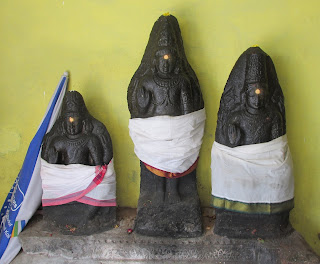Somangalam Somnath Ishwar Temple
Somangalam, a charming locale near Tambaram in Tamil Nadu, boasts an ancient Chola temple dedicated to Somnath Ishwar. Join us in discovering the exquisite architecture and spiritual significance of this temple.
Highlights:
- God - Somnath Ishwar
- Goddess - Kamakshi
- Sthala Vruksha (Sacred Tree) - Sara Kondrai (yellow laburnum)
- Sthala Teerth (Holy Tank) - Soma Teerth
- One of Navagraha Sthalams in Chennai
- Soma (Chandra) Sthalam
- Ancient Chola period Gaja prshtha temple
- Koshta idols such as Dakshinamurti, Vishnu and Brahma are found along with their vahanas
- Nandi is facing its backside to Shiva
- The stone image as well as the utsav image of Skanda is in the form of Brahma Shasta
- The unique Chatura Tandav posture of Nataraj
Legend:
According to one legend, Chandra sought refuge at this site after being cursed by his father-in-law, Daksha. He bathed in the temple tank and prayed to Lord Shiva, relieving himself of the curse. Thus, Lord Shiva is known as Somnath Ishwar here. Another name for Chandra is Soma, and this temple holds significance as a Soma (Chandra) Sthalam.
In a different legend, during the construction of the temple, enemies invaded the region. With his soldiers occupied in temple construction, the Chola King had no one to defend against the invaders. He prayed to Lord Shiva, who directed Nandi, Shiva's holy bull, to battle the enemies. Nandi faced eastward and defeated the invaders without moving from his position. As a reward, Shiva decreed that Nandi must forever guard this site and, thus, Nandi never turns his back to Lord Shiva here.
History:
The temple, believed to be at least 700 years old, was constructed by Kulotunga Chola in 1073 CE. This temple originally had an extensive historical name: Jayankonda Chola Mandalaththu Chenkattuk Kottaththu Maganoor Nattu Chomangalamana Rajasigamani Chaturvedi Mangalam.
Temple Layout:
The temple itself faces east, featuring an entrance situated to the south. Notably, it lacks a grand tower (gopura). In front of the temple, there is the temple tank known as Chandeeswara Teerth. Another tank, named Soma Teerth, can be located approximately 500 meters from the temple's premises. This temple is under the custodianship of the Archaeological Survey of India (ASI).
This temple stands as a splendid example of Chola period architecture. However, as part of the renovation efforts, ASI has applied a rather vibrant color scheme to the temple, which some may find incongruous with its historical aesthetics.
Sanctum
The sanctuary faces east and houses a substantial Shiv Linga referred to as Somnath Ishwar. At the entrance of this sacred chamber resides a diminutive icon of Ganesha. The sanctuary features a vimana designed in the Gaja prshtha style.
Brahma Shasta Utsav image
Within the modest Maha Mandapa area, numerous festival images can be discovered. Among them, a particularly unique presence is Kartikeya depicted in the form of Brahma Shasta. In this portrayal, Kartikeya grasps an Akshara Mala and a Kamandalu (sacred pot) instead of the customary weaponry. This form is genuinely scarce to encounter, and even rarer is finding a metal festival idol of Kartikeya in this guise. Typically, temples only exhibit Brahma Shasta in stone form.
Chatura Tandav Nataraja
An additional intriguing festival image is the Nataraja. Unlike the conventional dance postures found in other temples, here Nataraja assumes the Chatura Tandava stance. In this interpretation, Nataraja's two upper arms uphold a Damaru (drum) and a Kaalagni (flame cup) as usual. However, his lower hand is raised in Abhaya mudra, while the other lower arm dangles loosely. His legs are bent at the knees to form a square shape, making this image an incredibly unique and rare depiction.
Nandi
The flagstaff and bali peetha face the main shrine, as customary. Nevertheless, Nandi's orientation deviates from the norm in this temple; it faces the same direction as Shiva, an unusual feature.
Adjacent to the main shrine, a mandapa provides the sole entryway to the sanctum. Within this mandap, a splendid image of Ganesha can be observed. Furthermore, this mandapa harbors three Chola period stone icons—Brahma, Vishnu, and Kartikeya. If one examines Kartikeya closely, they'll discern that he is depicted in the form of Brahma Shasta.
There is a sub-shrine in this mandap that is dedicated to a beautiful Kandaswami. Again, he is also in the form of Brahma Shasta.
This temple is distinctive for having a total of three Brahma Shasta images, an exceedingly rare occurrence.
Kamakshi
The temple's presiding deity is Kamakshi, housed in a distinct south-facing shrine. This shrine includes an anterior mandapa with images of Ganesha and Kartikeya positioned at the entrance.
Koshta images
The Koshta icons within the temple are exquisitely crafted and include Ganesha, Dakshinamurti, Vishnu, Brahma, and Durga. Chandikeshwara retains his customary position. Remarkably, these deities are accompanied by their respective vahanas (mounts). Dakshinamurti, for example, is sculpted with a miniature representation of Nandi, while Vishnu is adorned with Garuda, and Brahma is accompanied by a swan.
Other Deities
The temple precinct is vast, offering ample open space. Within the vicinity, one can explore sub-shrines dedicated to Ganesha and Murugan-Valli-Devasena. Facing the main sanctum are the sub-shrines of Chandra and Surya, featuring a prominent idol of Chandra. The prakara further accommodates sub-shrines dedicated to Bhairava and the Navagrahas (nine planetary deities). An additional Shiv Linga is discovered under a sculpted holy tree, referred to as Vruksha Lingam.
Happy travelling.








.JPG)
Comments
Post a Comment